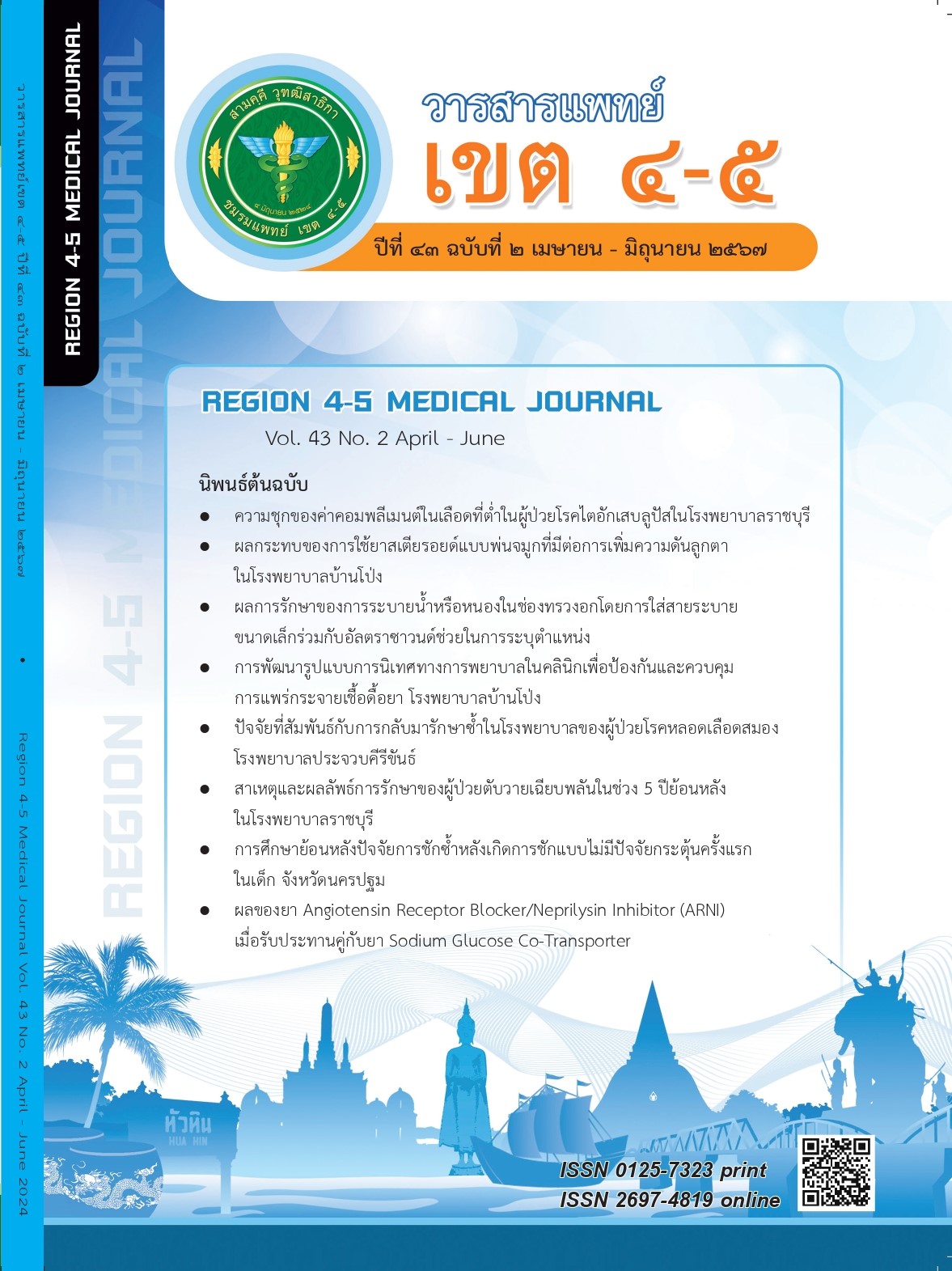ผลกระทบของการใช้ยาสเตียรอยด์แบบพ่นจมูกที่มีต่อการเพิ่มความดันลูกตาในโรงพยาบาลบ้านโป่ง
คำสำคัญ:
ยาสเตียรอยด์พ่นจมูก, ความดันลูกตา, บูเดโซไนด์, ฟลูติคาโซน, ฟูโรเอทบทคัดย่อ
วัตถุประสงค์: เพื่อศึกษาผลกระทบของการใช้ยาสเตียรอยด์แบบพ่นจมูกที่มีผลต่อการเพิ่มความดันลูกตาและเปรียบเทียบดูความดันลูกตาระหว่างการใช้ยาพ่นจมูกสเตียรอยด์ budesonide และ fluticasone furoate ในผู้ป่วยจมูกอักเสบจากภูมิแพ้ ในโรงพยาบาลบ้านโป่ง
วิธีการศึกษา: เป็นการศึกษาแบบ randomized prospective cohort study ในผู้ป่วยที่ได้รับการวินิจฉัยว่าเป็นจมูกอักเสบจากภูมิแพ้ที่มีอาการปานกลางถึงรุนแรง และมีอาการคงอยู่นาน (persistent symptoms) ในโรงพยาบาลบ้านโป่ง ในช่วงเวลาตั้งแต่ 1 มิถุนายน พ.ศ. 2566 ถึง 31 ธันวาคม พ.ศ. 2566 เป็นระยะเวลา 6 เดือน ที่มีข้อบ่งชี้ในการใช้ยาสเตียรอยด์พ่นจมูกในผู้ป่วยอายุ 18–70 ปี ที่มีความดันลูกตาปกติ (<21 มิลลิเมตรปรอท) ไม่มีต้อกระจกหรือต้อหิน ไม่มีโรคเบาหวานและความดันโลหิตสูง ก่อนการได้รับยาจำนวน 62 ราย ผู้ป่วยทุกรายได้รับการวัดความดันลูกตา ก่อนใช้ยาสเตียรอยด์พ่นจมูก และวัดซ้ำหลังใช้ยาพ่นจมูกต่อเนื่องที่ 1 เดือน, 3 เดือน, และ 6 เดือน เปรียบเทียบดูความดันลูกตาระหว่างการใช้ยาพ่นจมูกสเตียรอยด์ budesonide กับ fluticasone furoate โดยวิเคราะห์เปรียบเทียบการเปลี่ยนแปลงความดันลูกตาก่อนและหลังใช้ยาโดยใช้สถิติ repeated measures ANOVA และเปรียบเทียบดูการเปลี่ยนแปลงความดันลูกตาระหว่างยา โดยใช้สถิติ two-way repeated measures ANOVA
ผลการศึกษา: ค่าเฉลี่ยความดันลูกตาก่อนได้รับยาสเตียรอยด์พ่นจมูก budesonide เท่ากับ 14.15 ± 2.27 มิลลิเมตรปรอท และหลังได้รับยาสเตียรอยด์ต่อเนื่อง 1 เดือน, 3 เดือน, และ 6 เดือน เท่ากับ 14.47 ± 2.88, 14.53 ± 2.77, และ 14.26 ± 2.39 มิลลิเมตรปรอท ส่วนค่าเฉลี่ยความดันลูกตาก่อนได้รับยาสเตียรอยด์พ่นจมูก fluticasone furoate เท่ากับ 14.75 ± 2.67 มิลลิเมตรปรอท และหลังได้รับยาสเตียรอยด์ต่อเนื่อง นาน 1 เดือน, 3 เดือน, และ 6 เดือน เท่ากับ 14.27 ± 2.39, 14.37 ± 2.29, และ 14.65 ± 2.39 มิลลิเมตรปรอท ค่าความดันลูกตาทั้งก่อนและหลังการใช้ยาสเตียรอยด์พ่นจมูก budesonide และ fluticasone furoate ไม่มีความแตกต่างอย่างมีนัยสำคัญทางสถิติ (p = .974, p = .640) และเปรียบเทียบค่าความดันลูกตาระหว่างยาก็ไม่มีความแตกต่างอย่างมีนัยสำคัญทางสถิติ (p = .495)
สรุป: การใช้ budesonide และ fluticasone furoate ต่อเนื่องกันในขนาดยาที่ปกติเป็นเวลา 6 เดือน ไม่มีผลต่อความดันลูกตาอย่างมีนัยสำคัญทางสถิติ และความดันลูกตาหลังจากการใช้ยา budesonide กับ fluticasone furoate ไม่มีความแตกต่างกันอย่างมีนัยสำคัญทางสถิติ ดังนั้นการใช้ยาสเตียรอยด์แบบพ่นจมูกจึงมีความปลอดภัยในการใช้ในระยะยาว
เอกสารอ้างอิง
International Consensus Report on diagnosis and management of rhinitis. International Rhinitis Management Working Group. Allergy 1994;49(19 suppl):S1–34.
Sibbald B. Epidemiology of allergic rhinitis. Monogr Allergy 1993;31:61–79.
Wuthrich B, Schindler C, Leuenberger P, et al. Prevalence of atopy and pollinosis in the adult population of Switzerland (SAPALDIA study). Swiss study on air pollution and lung diseases in adults. Int Arch Allergy Immunol 1995;106(2):149–56. doi: 10.1159/000236836.
Strachan D, Sibbald B, Weiland S, et al. Worldwide variations in prevalence of symptoms of allergic rhinoconjunctivitis in children: the international study of asthma and allergies in childhood (ISAAC). Pediatr Allergy Immunol 1997;8(4):161–76. doi: 10.1111/j.1399-3038.1997.tb00156.x.
Vichyanond P, Jirapongsananuruk O, Visitsuntom N, et al. Prevalence of asthma, rhinitis and eczema in children from the Bangkok area using the ISAAC (Inter- national study for asthma and allergy in Children) questionnaires. J Med Assoc Thai 1998;81(3):175–84.
Tuchinda M. Prevalence of allergic diseases in students of Mahidol University. Siriraj Hosp Gaz 1978;30:1285–98.
Gevorgyan A, Segboer CL, Chusakul S, et al. Intranasal corticosteroids for non-allergic rhinitis. Cochrane Database Syst Rev 2013;11:1465–858. doi:10.1002/14651858.CD010592
Maniaci A, Merlino F, Cocuzza S, et al. Endoscopic surgical treatment for rhinogenic contact point headache: systematic review and meta-analysis. Eur Arch Otorhinolaryngol 2021;278(6):1743–53. doi: 10.1007/s00405-021-06724-6
Van Cauwenberge P, Bachert C, Passalacqua, et al. Consensus statement on the treatment of allergic rhinitis. Allergy 2000;55(2):116–34. doi: 10.1034/j.1398-9995.2000.00526.x.
Bui CM, Chen H, Shyr Y, et al. Discontinuing nasal steroids might lower intraocular pressure in glaucoma. J Allergy Clin Immunol 2005;116(5):1042–7. doi: 10.1016/j.jaci.2005.07.031.
Manji J, Singh G, Okpaleke C, et al. Safety of long-term intranasal budesonide delivered via the mucosal atomization device for chronic rhinosinusitis. Int Forum Allergy Rhinol 2017;7(5):488–93. doi: 10.1002/alr.21910.
Zain AM, Md Noh UK, Hussein S, et al. The relationship between long-term use of intranasal corticosteroid and intraocular pressure. J Glaucoma 2019;28(4):321–4. doi: 10.1097/IJG.0000000000001164.
Wijnants D, Stalmans I, Vandewalle E. The effects of intranasal, inhaled and systemic glucocorticoids on intraocular pressure: a literature review. J Clin Med 2022;11(7):2007. doi: 10.3390/jcm11072007.
Sihota R, Konkal VL, Dada T, et al. Prospective, long-term evaluation of steroid-induced glaucoma. Eye (Lond) 2008;22(1):26–30. doi: 10.1038/sj.eye.6702474.
Garbe E, Lelorier J, Boivin J, et al. Inhaled and nasal corticosteroids and the risk of ocular hypertension or open-angle glaucoma. JAMA 1997;277(9):722–7.
Garbe E, Lelorier J, Boivin J, et al. Risk of ocular hypertension or open-angle glaucoma in elderly patients on oral glucocorticoids. Lancet 1997;350(9083):979–82. doi: 10.1016/S0140-6736(97)03392-8.
Agarwal HC, Sood NN, Kalra BR, et al. Secondary glaucoma. Indian J Ophthalmol 1982;30(3):121–4.
Jones R, Rhee DJ. Corticosteroid-induced ocular hypertension and glaucoma: a brief review and update of the litera-ture. Curr Opin Ophthalmol 2006;17(2):163–7. doi: 10.1097/01.icu.0000193079.55240.18.
Teeraboonyakul W, Wuttiwongsanon C. A study of intranasal steroids on the change of intraocular pressure in patients with upper respiratory tract diseases at Bangplee Hospital. J Med Health Sci 2021;28(2):58–65.
ปิยพงษ์ บำรุง, ชลธิชา จารุมาลัย, ทรงกลด เอี่ยมจตุรภัทร. การศึกษาผลของยาพ่นจมูกคอร์ติโคสเตียรอยด์ต่อความดันลูกตา. วารสาร หู คอ จมูก และใบหน้า 2553;11(4):147–54.
ปิยพงษ์ บำรุง. การศึกษาผลของยาพ่นจมูกคอร์ติโคสเตียรอยด์ต่อความดันลูกตาในผู้ป่วยโรคเยื่อบุจมูกอักเสบจากภูมิแพ้ในโรงพยาบาลมุกดาหาร. ยโสธรเวชสาร 2559;18(2):49–55.
Ciprandi G, Canonica WG, Grosclaude M. et al. Effects of budesonide and fluticasone propionate in a placebo-controlled study on symptoms and quality of life in seasonal allergic rhinitis. Allergy 2002;57(7):586–91. doi:10.1034/j.1398-9995.2002.03228.x.
Stern MA, Dahl R, Nielsen LP, et al. A comparison of aqueous suspensions of budesonide nasal spray (128 μg and 256 μg once daily) and fluticasone propionate nasal spray (200 μg once daily) in the treatment of adult patients with seasonal allergic rhinitis. Am J Rhinol 1997;11(4):323–30. doi:10.2500/105065897781446658.
Baek SU, Kee C, Suh W. Longitudinal analysis of age-related changes in intraocular pressure in south korea. Eye (Lond) 2015;29(5):625–9. doi:10.1038/eye.2015.11.
Qureshi IA. Age and intraocular pressure: how are they correlated?. J Pak Med Assoc 1995;45(6):150–2.
Jeelani M, Taklikar RH, Taklikar A, et al. Variation of intraocular pressure with age and gender. NJPPP 2014;4(1):57–60. doi:10.5455/njppp.2014.4.040720132
Sharfuddin Ahmed M, Ullah AY, Barman N, et al. Risk factors associated with elevated intraocular pressure: a population-based study in a rural community of Bangladesh. BMJ Open Ophthalmol 2023;8(1):e001386. doi:10.1136/bmjophth-2023-001386.
Ah-Kee EY, Li Yim JF. Bilateral acute angle closure glaucoma precipitated by over the counter oral decongestant. Int J Ophthalmol 2014;7(2):387–8. doi:10.3980/j.issn.2222-3959.2014.02.35.
Mortimer KJ, Tattersfield AE. Benefit Versus Risk for Oral, Inhaled, and Nasal Glucocorticosteroids. Immunol Allergy Clin North Am 2005;25(3):523–39. doi: 10.1016/j.iac.2005.05.002.
Benninger MS, Ahmed N, Marple BF. The safety of intranasal steroids. Otolaryngol Head Neck Surg 2003;129(6):739–50. doi:10.1016/j.otohns.2003.10.001.
ดาวน์โหลด
เผยแพร่แล้ว
รูปแบบการอ้างอิง
ฉบับ
ประเภทบทความ
สัญญาอนุญาต

อนุญาตภายใต้เงื่อนไข Creative Commons Attribution-NonCommercial-NoDerivatives 4.0 International License.
ลิขสิทธิ์บทความเป็นของผู้เขียนบทความ แต่หากผลงานของท่านได้รับการพิจารณาตีพิมพ์ลงวารสารแพทย์เขต 4-5 จะคงไว้ซึ่งสิทธิ์ในการตีพิมพ์ครั้งแรกด้วยเหตุที่บทความจะปรากฎในวารสารที่เข้าถึงได้ จึงอนุญาตให้นำบทความในวารสารไปใช้ประโยชน์ได้ในเชิงวิชาการโดยจำเป็นต้องมีการอ้างอิงถึงชื่อวารสารอย่างถูกต้อง แต่ไม่อนุญาตให้นำไปใช้ในเชิงพาณิชย์




